Germany 2010 "Time travel - Museum of Trossingen"
| << previous | back to index | next >> |
| Issue Date | 25.09.2010 |
| ID | Category: pF. |
| Design | Photograph: Volker Neipp, the Museum director. Stamp design: Bernd Messner and the museum's team. |
| Stamps in set | 1 |
| Value | €0.55- skull of Plateosaurus engelhardti |
| Type | commemorative |
| Size (width x height) | 320mm x260mm |
| Layout | Sheet of 20 self-adhesive stamps |
| Products | Commemorative Cover x1 |
| Paper | |
| Perforation | die-cut |
| Print Technique | |
| Printed by | |
| Quantity | 1.500 |
| Issuing Authority | Deutsche Post, Marke-inviduell |
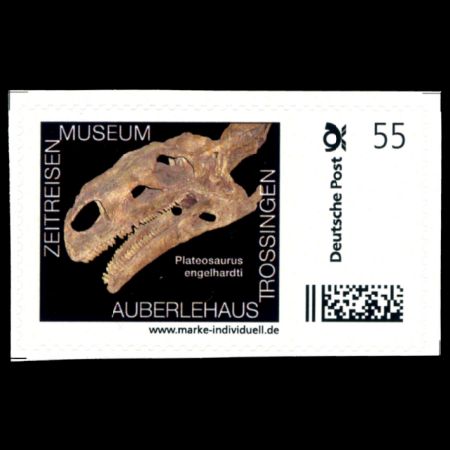
The self-adhesive, personalized stamp and the corresponding commemorative cover were introduced by Auberlehaus Lore Museum (in German: Heimatmuseum Auberlehaus) in Trossingen on the museum reopening event on October 9th, 2010. In June 2006, a hailstorm destroyed the building of the museum.
The stamp has the face value of 55 Euro cent, corresponding to the rate of domestic letter with weight up to 20gr.
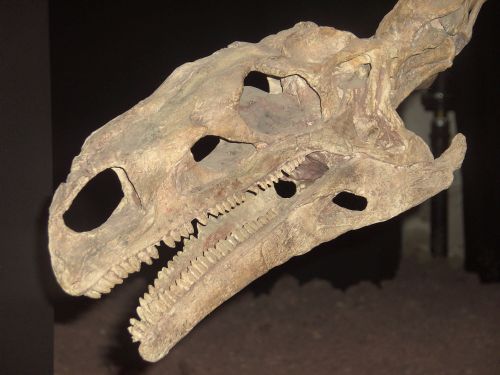 |
| The skull of the Plateosaurus Image credit trio-k.de |
In 2019, the International Commission on Zoological Nomenclature (ICZN) has designated
Plateosaurus trossingensis Fraas, 1913 as the type species of the genus Plateosaurus
Meyer, 1837 by setting aside all previous assignments of type species for this nominal genus
of sauropodomorph dinosaurs.
In other words, Plateosaurus engelhardti is an invalid name.
The fossils previously associated with Plateosaurus engelhardti are called
Plateosaurus trossingensis now.
According to recent research, there are not enough fossil materials to define it as separate species.
All fossils associated with Plateosaurus engelhardti included "roughly 45 bone fragments",
of which nearly half are lost.
Mr. Rudolph Hofer from Switzerland, the editor of the Paleoanthropology column of "Arbeitsgemeinschaft Bergbau und Geowissenschaften e. V." (Mining and Geosciences Working Group) Study Unit of the Association of German Philatelists (in German: Bund Deutscher Philatelisten - BDPh), helped the museum staff with selection of the photo for the stamp and provided some support for the stamp design.
The stamp presentation was organized by the Museum and philatelic club of Trossingen in the Fritz-Kiehn-Halle in Trossingen, as the museum doesn't have an event hall.
The idea to issue the personalized stamp was proposed by Meinhard Gericke an active member of the Trossingen philatelic club. Mr Gericke, the secretary and public relations officer of the museum association and one of the many tireless "creators" of the newly designed Auberlehaus museum explained:
"We hope, to increase the level of awareness of the museum with this stamp - the Auberlehaus goes around the world in such a beautiful design."
Plateosaurus is a genus of dinosaur that lived during the Late Triassic period,
around 214 to 204 million years ago, in what is now Central and Northern Europe.
Plateosaurus is a basal (early) sauropodomorph dinosaur, a so-called "prosauropod".
Currently, there are three valid species: Plateosaurus trossingensis,
Plateosaurus longiceps and
Plateosaurus gracilis.
Discovered (vertebrae and leg bones) in 1834 by Johann Friedrich Engelhardt and described three years
later by Hermann von Meyer, Plateosaurus was the fifth named dinosaur genus that is still considered
valid.
von Meyer named the species Plateosaurus engelhardti in honour of the discoverer.
Plateosaurus were the first known large herbivores among the dinosaurs.
Although it had been described before Richard Owen formally named Dinosauria in 1842, it was not one of the three genera used by Owen
to define the group, because at the time, it was poorly known and difficult to identify as a dinosaur.
Now it is among the dinosaurs best known to science: over 100 skeletons have been found, some of them nearly complete.
The abundance of its fossils in Swabia, Germany, has led to the nickname Schwäbischer Lindwurm (Swabian Dragon).
Plateosaurus was a bipedal herbivore with a small skull on a long, flexible neck, sharp but broad plant-crushing teeth,
powerful hind limbs, short but muscular arms and grasping hands with large claws on three fingers,
possibly used for defense and feeding.
Unusually for a dinosaur, Plateosaurus showed strong developmental plasticity: instead of having a fairly uniform adult size.
Some fossils suggest that this dinosaur may have lived in herds.
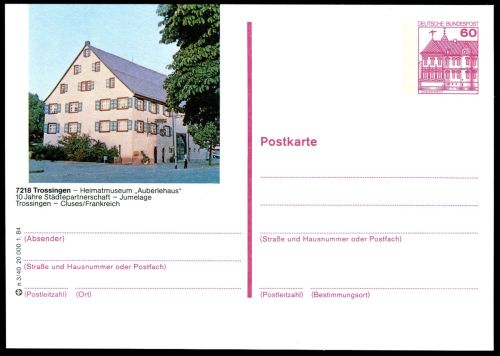 |
| Auberlehaus Lore Museum in Trossingen on the cachet of German postal stationery 1984 - "Lore museum Auberlehaus, 10 years city partnership between Trossingen and Cluses in France". |
Auberlehaus Lore Museum in Trossingen was established in 1977, in the renovated historic farmhouse from 1718 - the Auberlehaus in Trossingen. The building burned down in 1968.
In 1979 the cast of two Plateosaurus skeletons were installed in lively poses, in the Auberlehaus Lore Museum in Trossingen.
Since October 2014, the museum has also been one of 26 information points in the UNESCO Geopark Swabian Alb.
The Auberlehaus Lore Museum primarily contains information on the social history of the city in rooms and workshops reconstructed to look like they did in the early 18th to early 20th centuries.
In addition to the information about the development of Trossingen from an Alamannendorf to a music city, there is also a paleontological collection.
An exhibition on the subject of dinosaurs includes dinosaurs from different habitats, as well as petrified reefs, ammonites and turtles.
The walls, ceiling, and floors are painted black in the exhibit halls - the stark relief makes the mounted skeletons of the dinosaurs stand out impressively against this dark background. This makes the impressive exhibits particularly stand out.
 |
|
Plateosaurus skeletons and reconstruction on exhibit of the Auberlehaus Lore Museum in Trossingen. Plateosaurus was a facultative biped. It could have walked on its hindlimbs most of the time, but could also walk on all fours when necessary. Image credit: Auberlehaus Lore Museum in Trossingen |
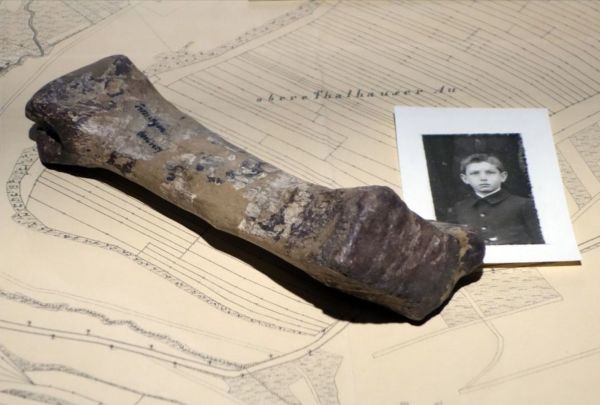 |
| The bone of Plateosaurus, discovered by Hermann Weiss with his photo. The bone is still kept in the Auberlehaus museum in Trossingen. Image credit bawue.museum-digital.de |
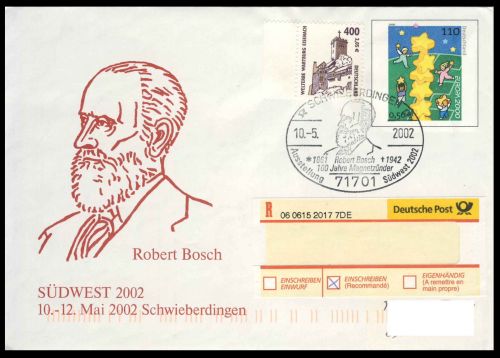 |
| Robert Bosch on commemorative postmark of Germany 2002 |
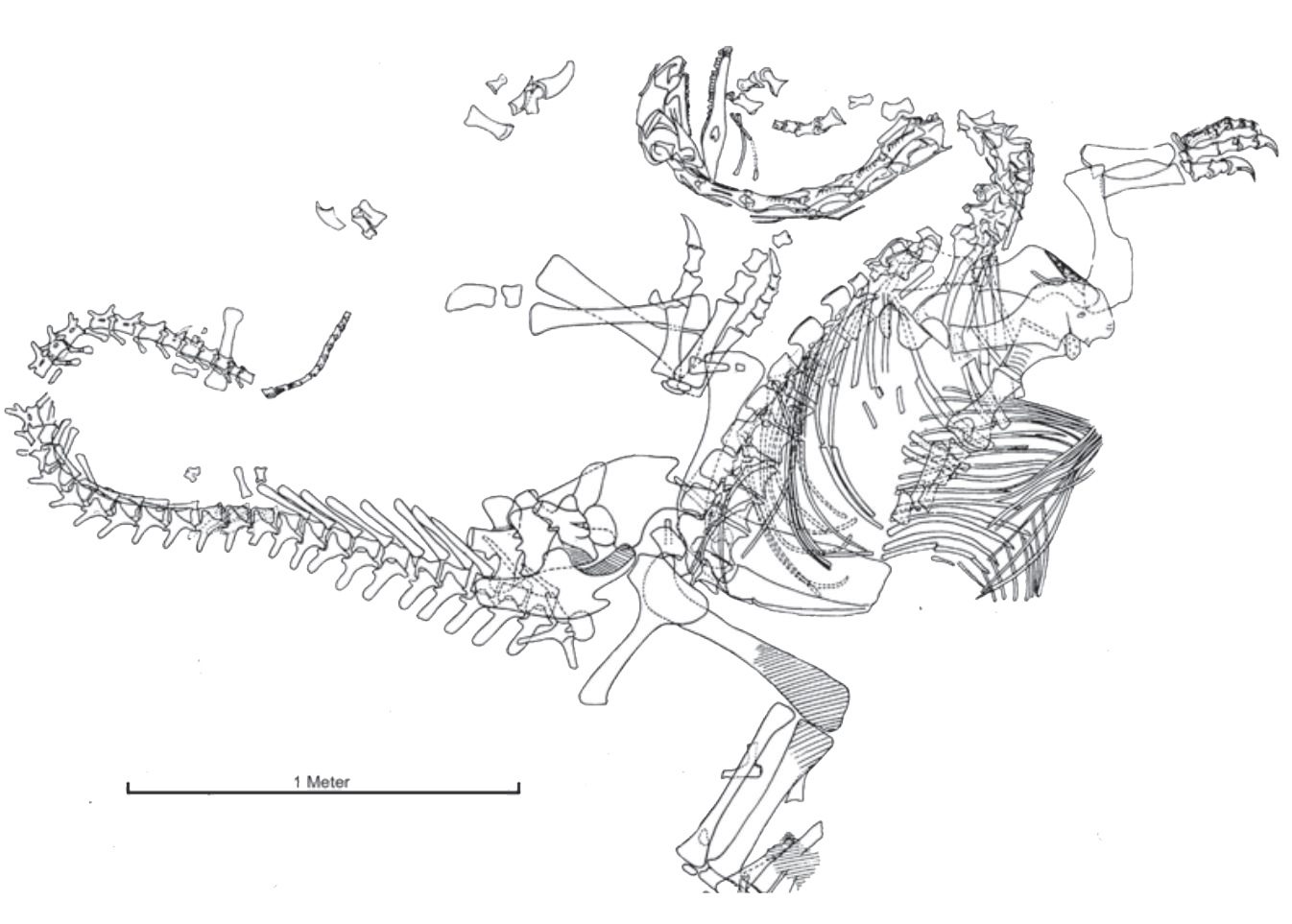 |
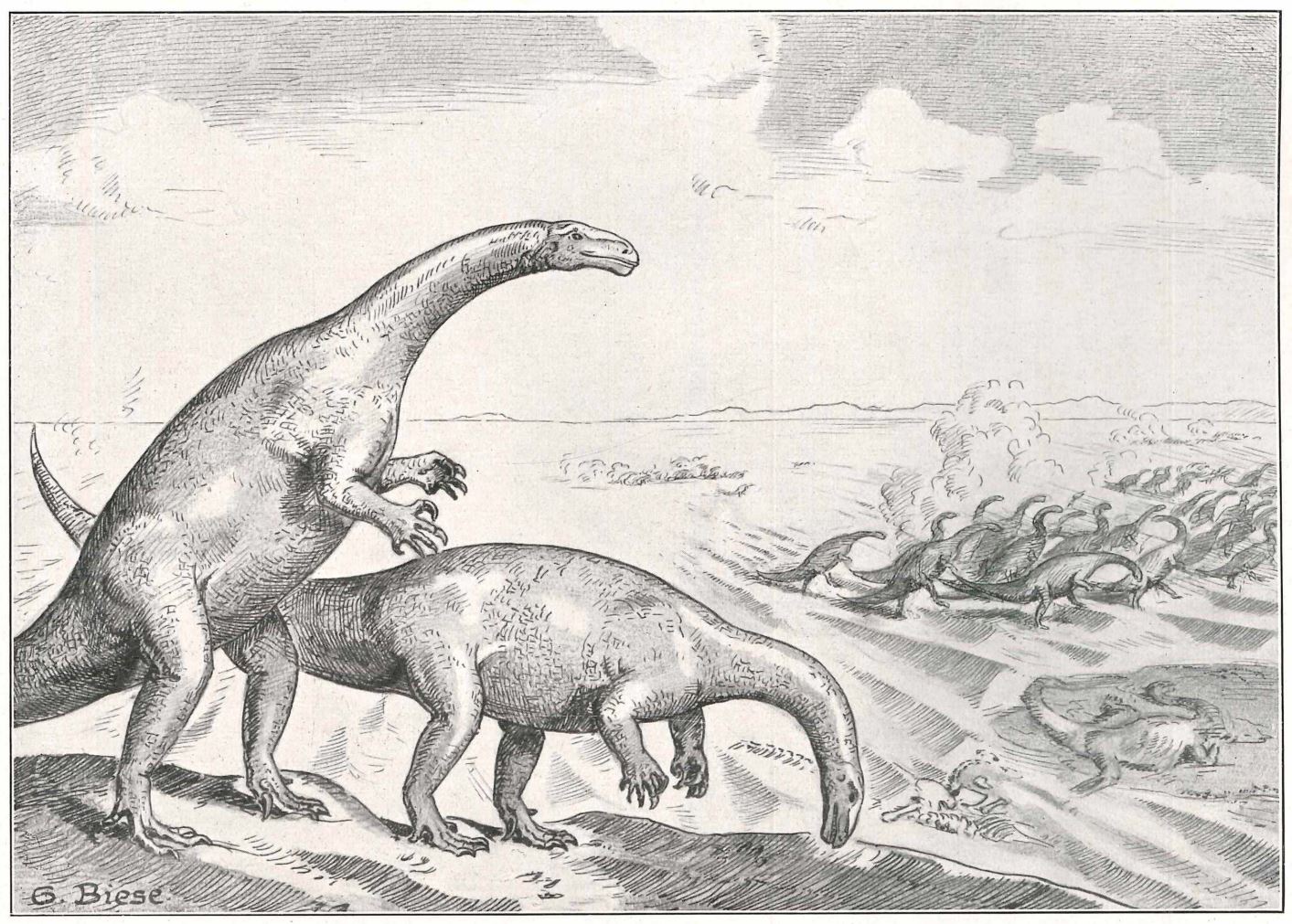 |
| Plateosaurus bones in the discovery posture and Plateosaurus reconstruction by Friedrich von Huene from his article "Lebensbilddes Saurischier-Vorkommens im obersten Keuper von Trossingen in Württemberg" from 1927. |
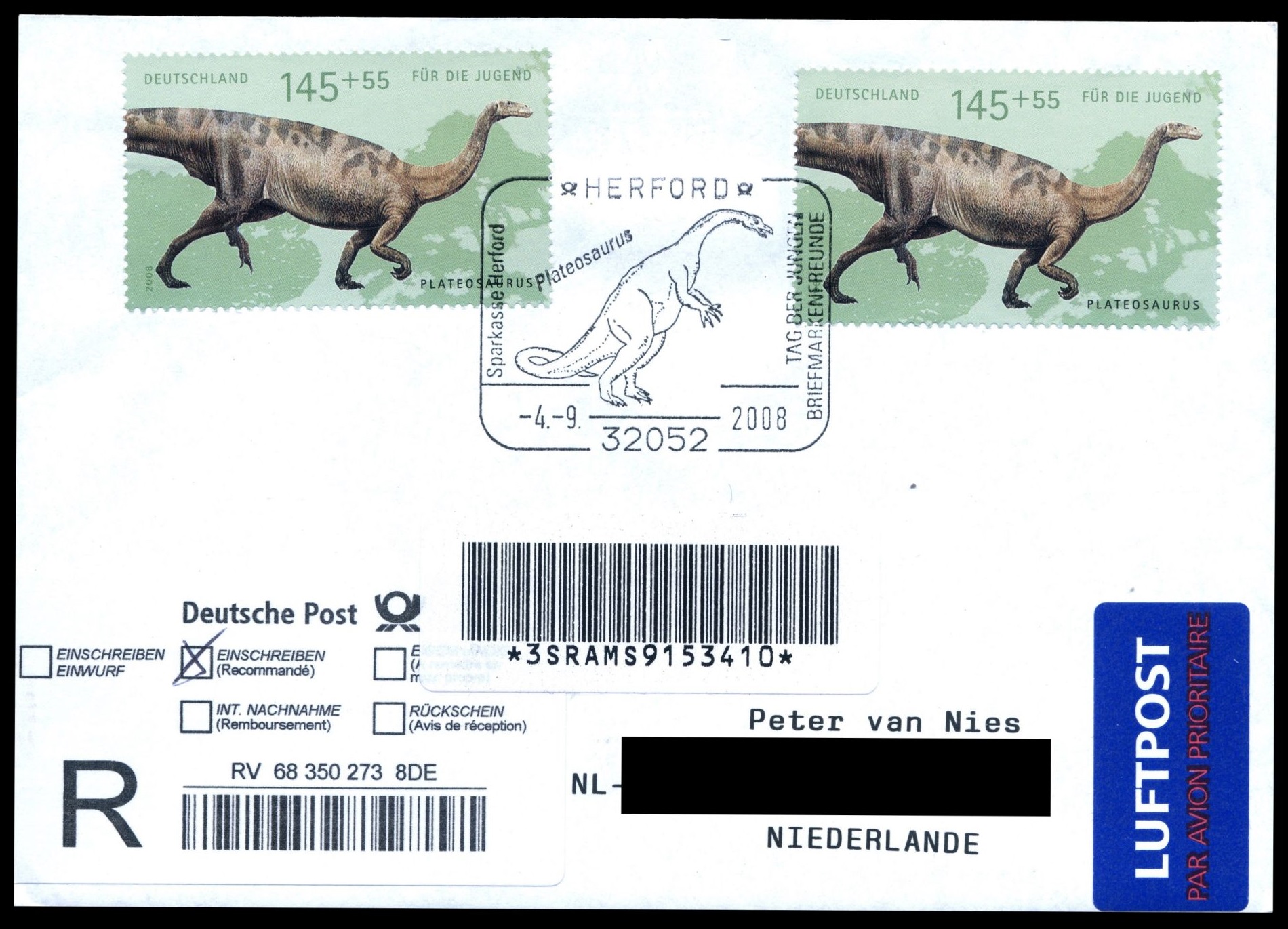 |
| Reconstruction of Plateosaurus on official stamp and commemorative postmark of Germany 2008. |
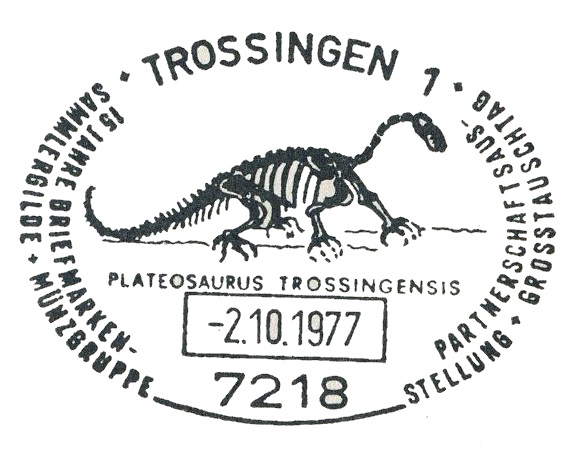 |
|
Skeleton of Plateosaurus trossingensis from collection of the Auberlehaus Lore Museum in Trossingen on postmark of Germany 1977. The postmark was designed by local architect Mr. Theo Huber, who was a good painter and designed several other postmarks of Trossingen. The postmark reproduces the skeleton of the first Plateosaurus discovered in Trossingen in 1912, painted by Hugo Wolff-Maage, published in "Das Leben der Urwelt" of Wilhelm Bölsche in 1931. (Chapter 6, image Nr. 100). The Plateosaurus described there as large and dangerous predatory dinosaur. The first appearance of Plateosaurus on a postal object is likely a postcard issued in 1910s. |
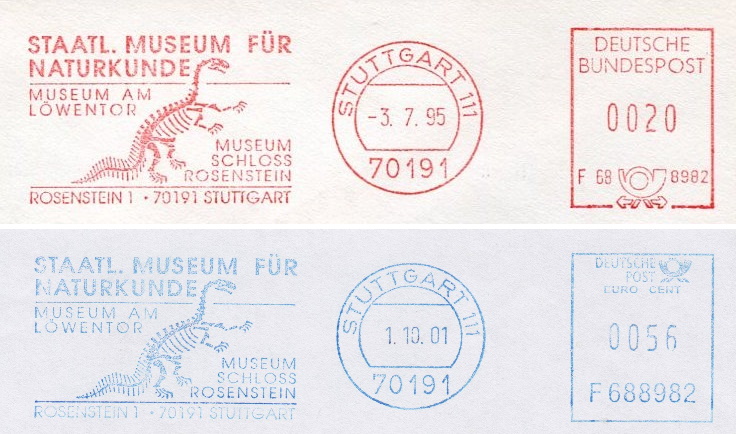 |
 |
| The skeleton and reconstruction of Plateosaurus on meter frankings of the State Museum of Natural History in Stuttgart. |
Trossingen is famous for two different localities separated by only a few hundred meters distance: the sandstone quarries at the Untere Mühle (lower mill) yielded archosaur bones from the Middle Stubensandstein, whereas the stratigraphically higher beds at “Obere Mühle” (upper mill) produced the numerous skeletons of Plateosaurus and the turtle Proganochelys. The Obere Mühle site – originally a steep slope some 20 m high – has probably always formed an attraction to children, especially when the red mudstones were slippery from rainfall.
The first Plateosaurus of Trossingen was discovered in 1909, when school children built a slide on a slope made of lumps of marl not far from the "Oberen Mühle". The boy Hermann Weiss tore his pants while sliding. As the children looked closely, they discovered several bones sticking out of the weathered rock.
Hermann brought the largest bone (metatarsal bone, 21cm x 7cm) to his teacher Gottlob Munz, who realized that the bone could not have come from a native animal and sent it to Professor Eberhard Fraas of the Württemberg Natural History Cabinet in Stuttgart (in German: Württembergischen Naturalienkabinetts in Stuttgart), the predecessor of today's State Museum of Natural History in Stuttgart (in German: Staatliches Museum für Naturkunde Stuttgart).
Prof. Fraas was famous for the dinosaur bones that he had discovered during his trip to German East Africa (now Tanzania). He discovered the famous dinosaur site, Tendaguru. Prof. Fraas examined the bone sent to him by Gottlob Munz and recognized that the bone was from a dinosaur.
In 1911, he visited the place where the boys found the bone. Together with his taxidermist Max Böck, they observed five potential sites that might contain more dinosaur remains.
By inspecting the place for his coming excavation he estimated the need to take away 2.000m3 of nodular marl. This was a big challenge, requiring time and human resources, which were well over the budget of the museum. Professor Fraas received the money for the excavation from the famous Robert Bosch (1861-1942), German industrialist from the Württemberg region, engineer and inventor, founder of Robert Bosch GmbH.
The excavation started in the same year, with the hope to unearth the full skeleton of the dinosaur.
It took almost a year of hard work for the team, when in September 1912, two almost complete dinosaur skeletons were found. One of the skeletons, 5.75 meters long, is to date (2022) one of the most complete and best-preserved Triassic Dinosaur skeletons ever found.
Its skull preserved all the teeth, and also preserved the fragile bony sclerotic ring. The sclerotic rings are delicate set of bones that protect the eyes found in many reptiles and birds. The preservation of such delicate bones suggest that this animal was rapidly buried and quickly fossilized.
The bones, were however, firmly embedded in rock. To preserve them, they were transported to the museum in big pieces of rock. It took over 5 months for the museum team to free them.
Professor Fraas recognized the animal as Plateosaurus and named the species Plateosaurus trossingensis.
Fraas noticed an unusual burial postures of the dinosaurs, the more complete skeletons were not just lying on their side, as is usual, but that the animal was "sitting", i.e., with bent legs and lying on their stomachs. He interpreted this as a sign that the dinosaur had sunk into mud.
These skeletons were mounted in 1913 in the State Museum of Natural History Stuttgart, where they can be seen today.
In 1920, paleontologist William Diller Matthew (1871-1930) from the American Museum of Natural History in New York visited the location where Plateosaurus was found, accompanied by the German paleontologist, Professor Friedrich von Huene from the University of Tübingen. Matthew assumed that more dinosaur fossils could be found there. His proposal for financial support of one excavation season included the condition that his museum would receive half of the excavated bones was accepted by von Huene.
The second excavation in Trossingen started in 1921 and continued for three seasons.
The financial support for the other two seasons were provided by local entrepreneurs Karl Koch, Matthias Hohner, and Andreas Hohner.
The von Huene's teams excavated bones of over a dozen Plateosaurus dinosaurs, as well as isolated bones of a turtle. One complete skeleton was sent to the American Museum of Natural History in New York, where it can be seen today.
As opposed to Fraas's model, von Huene envisioned a totally arid environment, supported by what he believed to be outlines of dunes in the Knollenmergel beds. He ruled out any water transport, pointing to the articulated nature and upright carcass position of the more complete finds.
He interpreted the common, oblique joints as dunes and suggested that the Plateosaurus assemblage was caused by a herd dying of exhaustion after a long march across a desert zone (see the drawing from his article on the right).
What he did not take into account was that bones were found in different horizons and thus the mass assemblage could not have been caused by a single event.
The third and the most prolific excavation of dinosaur bones in Trossingen was started in 1932 by the team of Dr. Reinhold Seemann from the State Museum of Natural History in Stuttgart, with financial support by Matthias Hohner.
Around 30 assistants from the voluntary labor service formed during the economic crisis at the time were involved, and they were supported by the city, employment offices and the Hohner company.
Apart from securing more skeletons for exhibition and study, his main interest was the acquisition of more reliable data on the formation of the deposits. The excavation area at the Oberen Mühle in the Trosselbachtal was 80,000 square meters and 750,000 cubic meters of earth were moved.
4 complete Plateosaur skeletons, 17 larger skeletal remains and single bones of 44 other individuals were discovered.
Many of these skeletons were discovered in the "sitting" positions too. On top of it, the team found three very well-preserved fossils of the turtle Proganochelis quendstedti, one of which with the complete skull preserved. (The turtle was depicted on a German commemorative postmark in 1988).
These primeval turtles are among the most valuable fossils ever found in Germany, because they provided detailed insights into the early evolution of this reptilian group.
The excavation ended rather tragically after a worker died in an accident. Due to rain-related landslides in the marl - a young worker was buried by a landslide after a heavy rainfall — a common and dangerous phenomenon in the Knollenmergel.
Of the 65 finds listed by Seemann, only 21 have survived the Second World War (Plateosaurus: 18, Proganochelys: 3). This includes most of the well-preserved skeletons, which had been moved to safe places during the war.
In his major publication, published in the following year, Seemann reported an abundance of data on the geology, geochemistry, and taphonomy of the locality.
He ruled out the aeolian hypothesis of von Huene, in which the deposits had formed in dunes of a red clay desert, and argued that the supposed outlines of dunes were in fact tectonic structures, namely, anticlines of 2–6 m in length.
As an alternative hypothesis, Seemann proposed that the Knollenmergel originated under aquatic conditions and suggested the existence of a lake in the Trossingen area.
According to recent research, 205 million years ago, southern Germany was in the catchment area of monsoon storms. The water drained to the large ocean to the south during the summer months. The landscape was shaped by the vigorous rainfall - which carved deep gullies where the waters drained. This environment would be similar to portions of modern Australia and the Southwestern United States where large puddles of water accumulated and lasted for months.
Such waterholes were safe, attractive places for animals of all kinds to congregate as they were a source of drinking water. No wonder turtles have been found at these locations. Animals would become trapped in the marl muds around and in the waterholes - but usually as individual animals that died lonely deaths every few hundred years instead of large herds.
The marls are over twelve meters thick and the accumulation of these sediments likely took a long time. That means the animals didn't fall victim to any catastrophes, the whole affected herds. It's much more likely individual, lonely death of perhaps an animal every few hundred years.
The excavation, which was preceded by that of Eberhard Fraas (1911/12) and Friedrich von Huene (1921/22), was the largest dinosaur excavation ever to take place in Germany.
After the 1932 excavation, the Trossingen locality was overgrown by woodland.
For the first time since 1932, the Trossingen locality was reopened by the Stuttgart Natural History Museum (SMNS) in September 2007. The excavation was led by Professor Dr. Rainer Schoch, the head of the Paleontology department at the Stuttgart Natural History Museum. Excavations continue with some interruptions up to the present date (2022).
| "FDC" [1] | Commemorative Cover [2] | |
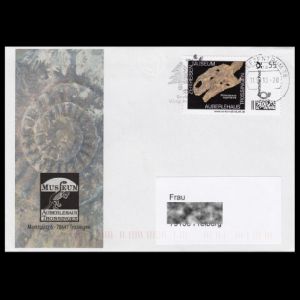 |
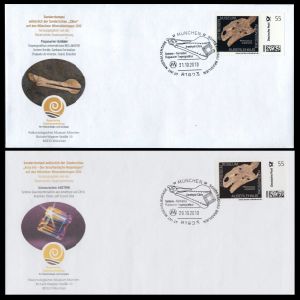 |
Notes:
[1] This cover, a kind of FDC (First Day Cover), was produced by the Museum Auberlehaus in Trossingen. The stamp and the cover were on sale since September 25th, 2010 (two weeks before the stamp release ceremony). The stamp was sold for price of €2, the cover was sold for price of €2.50.
The cover was sent from Trossingen on the stamp presentation event, on October 10, 2010. It was cancelled in Briefzentrum 78, the next letter sorting center, in Villingen-Schwenningen, only 16km away.
[2] 400 of 1.500 stamps were purchased by the Paleontological Museum of Munich, who used it on their commemorative covers, presented at the annual Fossils and Minerals Trade Show in Munich.
(The Paleontological Museum of Munich, always has a big booth in the Fossil hall of the Trade Show, where they sell Paleontology and Geology relevant printed materials. They also create different, topical fossil exhibits.) They also used official German postage stamp "Bicentenary of Museum fuer Naturkunde in Berlin", issued in the same year, on the postcards with the similar cachet (according to stamps face values).
References:
- Technical details:
- "Saurier auf einer Briefmarke"
- "Briefmarke zum Jubiläum des Trossinger Auberlehauses?"
- Glückauf Nr. 113, 114 - the magazine of "Arbeitsgemeinschaft Bergbau und Geowissenschaften e. V." (Mining and Geosciences Working Group) philatelic club.
SÜDWEST PRESSE / DIE NECKARQUELLE (in German) - Plateosaurus:
- Wikipedia
- Encyclopedia Britannica
- NHM UK
- The Bulletin of Zoological Nomenclature, 76(1): 144-145 - "Opinion 2435 (Case 3560) – Plateosaurus Meyer, 1837 (Dinosauria, Sauropodomorpha): new type species designated"
- "Das Leben der Urwelt" by Wilhelm Bölsche published in 1931
- Plateosaurus excavation near Trossingen:
- "Taphonomy, deposition and pedogenesis in the Upper Triassic dinosaur beds of Trossingen", by Rainer R. Schoch & Dieter Seegis, published on-line on July 2nd 2014. DOI 10.1007/s12549-014-0166-8.
- "Plateosaurus: Der Deutsche Lindwurm", by Ernst Probst and Raymund Windolf, ISBN-13: 979-8481617138
- "Die neuesten Dinosaurierfunde in der schwäbischen Trias", by Professor Eberhard Fraas, published in Die Naturwissenschaften vol. 1 in 1913, pages 1097-1100
- "Auf Saurierjagd in Trossingen - seit 100 Jahren. Schwäbische Heimat 2011", by Rainer Schoch
- "Tracing SEEMANN’s dinosaur excavation in the Upper Triassic of Trossingen: his field notes and the present status of the material", by Rainer Schoch. Palaeodiversity 4: 245–282; Stuttgart 30 December 2011.
- NHM Stuttgart (in German)
- Museum Auberlehaus in Trossingen
- official website
- Wikipedia (in German)
- trossingen.de
- Trossingen: Wikipedia
- Eberhard Fraas: Wikipedia
- Friedrich von Huene: Wikipedia
- Reinhold Seemann: Wikipedia (in German)
- Rainer Schoch: NHM Stuttgart (in German)
Acknowledgements:
Many thanks to Dr. Peter Voice from Department of Geological and Environmental Sciences, Western Michigan University, for reviewing the draft page and his very valuable comments.
| << previous | back to index | next>> |